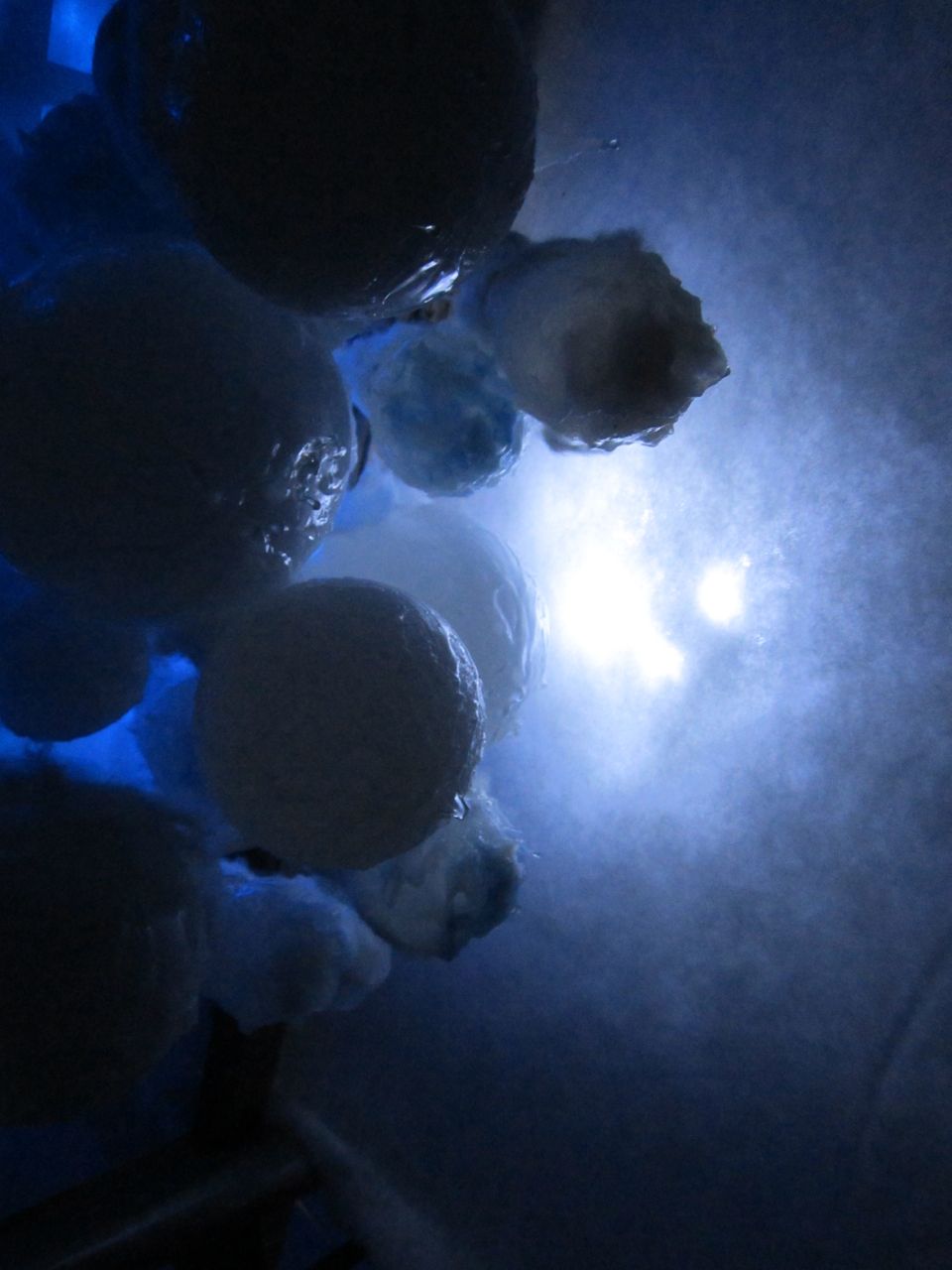Performance (2 hours durational) of continual lighting of matches in a darkened room (adjacent to blue chamber shown below) lit only by a dim flickering wall lamp and each match upon lighting, plunging into darkness and being re-lit again and again. Sitting all the while atop a pile of dirt in a wooden chair. Installation housed a continued video of this action over the two week show.
Singular audiences were encouraged to lay beneath a false floor (basic scaffolding), head on grass, and peer up into the crystaline ceiling to a soundscape and slow pulsing blue light.
Metro Arts Galleries
September 2011
Brisbane, Australia
Installation view

Blue Immersive chamber



Critical Writings on the work by Doug Leonard and Rebecca Cunningham:
Melody Woodnutt's installation embodies in a rich image something of the excitement of the process of becoming. Yet at the same time it addresses the enigmatic presence of things. The world here is not dead or inert, but discloses a power that surpasses every effort at reduction into scientific, determinate concepts. In this sense her art aids in our recuperation of the sense that the world is not sterile as she solicits our imaginative rapport with being in all its otherness.
At the same time, Woodnutt concurs with the French philosopher Sartre that the mind likewise cannot be reduced to observable phenomena whether, say, of a behaviourist or Freudian ilk. To do so would be to destroy the world's instantaneous kernel, to neglect that which is the sovereign source of meaning since consciousness is at all times sovereign, at all times responsible, since there is no 'rational nature' in Sartre's metaphysic to take over the job of fixing the meaning of even a part of the universe.
The absurdity of the world can lead to an experience of profound apathy, represented by Woodnutt in the classically futile gesture of striking and extinguishing matches. Nevertheless, there is another side to this condensed imagery. Apatheia is a classic virtue originally extolled by the Greek Stoics, but in this context perhaps is best explicated through the thoughts of Evagrius, an early Christian Desert Father. A contemporary, Balthasar, wrongly called Evagrius a Buddhist. Wrong, but a certain truth here. There’s a calm, a slight smile: that’s apatheia, passionlessness. You’re not a driven person. You still have emotions, but they don’t drive you. They don’t disintegrate you. For Evagrius, it’s a centering, bringing the fractured self into a whole. Also it touches your dreams: these are markings of our unconscious. Also then the spirit begins to see its own light, to have experiences (mystical) of “light.” Wordless, imageless, unceasing.
Becoming is grounded in the appearance of an infinite reserve, such that every seeming stasis is but slumbering energy that with time will wake. This reserve, never exhausted by determinate objectifications or diminished by particular things, is related to what the poet Gerard Manly Hopkins, speaking of the grandeur of creation despite its sometimes soiled surface, calls “the dearest freshness deep down things”. All things selve, Hopkins believed. But we selve through an interiorising movement to self-presence.
The self may give back an articulated image of the protean unity and multiplicity of the world by becoming this manifoldness in its own self-relating singleness. In this we find, so to say, the mirror in which becoming can behold and inspect itself and raise the event of appearance and disappearance to a new level of articulation. Think here of Rilke's celebrated lines in the Ninth Duino Elegy: “Earth, is this not what you want, invisibly/ To arise in us?” -Douglas Leonard, 2011.
Apathy and Wonder explores the body in space – the body in environment.
As we enter the space we approach two worlds – the internal and external, the dark and light, Apatheia & the Theatre of Situation. In each space, the audience is live and active in the work, co-creating the work and the experience for themselves, and those around them. During the opening of this work, the artist is present in Apatheia. She sits in surrealist futuristic aeronautical garb and lights a match – it flickers in the dark and slowly slowly dissipates. Another match is struck, again and again, a repetitious cycle of destruction, creation and meditation.
For the remainder of the exhibition a projection of this action replaces the body – the virtual body of the artist remains in the installation throughout its duration. Over and over again, the match is struck, the flame burns, and disappears, only to reignite again. Apatheia is not apathy, but rather originates from the Greek ἀπάθεια – a state of acceptance.
Within the Theatre of Situation, the body of the audience is central to the experience of the work. Each of us are invited to explore and intermingle in a world of light, inspired by ice and storm; where the beginning of the performance starts and where it ends is all in our perception and presence of self and space.
In Woodnutt’s environment Apathy and Wonder, she creates a state of investigation and play available to the audient – a space to explore and consider. Our presence in the work is critical to the completion of the work. In conversation with the artist Woodnutt says the audience is “IN the work, and as such a direct part of the work, both unpredictable, and constructive to the composition of the work itself”. In Apathy and Wonder, the artist has made an environment whereby our bodies contribute to the work producing a “breathing-live-space”. This essential liveness is ephemeral and intrinsically experiential. As soon as one writes about the work or talks about performance, according to Phelan, the work ceases to be performance and becomes something else. (1993). As such, I encourage you to see the work, be in the work and experience the work for yourself. - Rebecca Clunn-Cunningham, 2011.
Phelan, P. (1993). Unmarked: The Politics of Performance. London: Routledge.
Source Images for the work - Seljalandsfoss, Iceland


